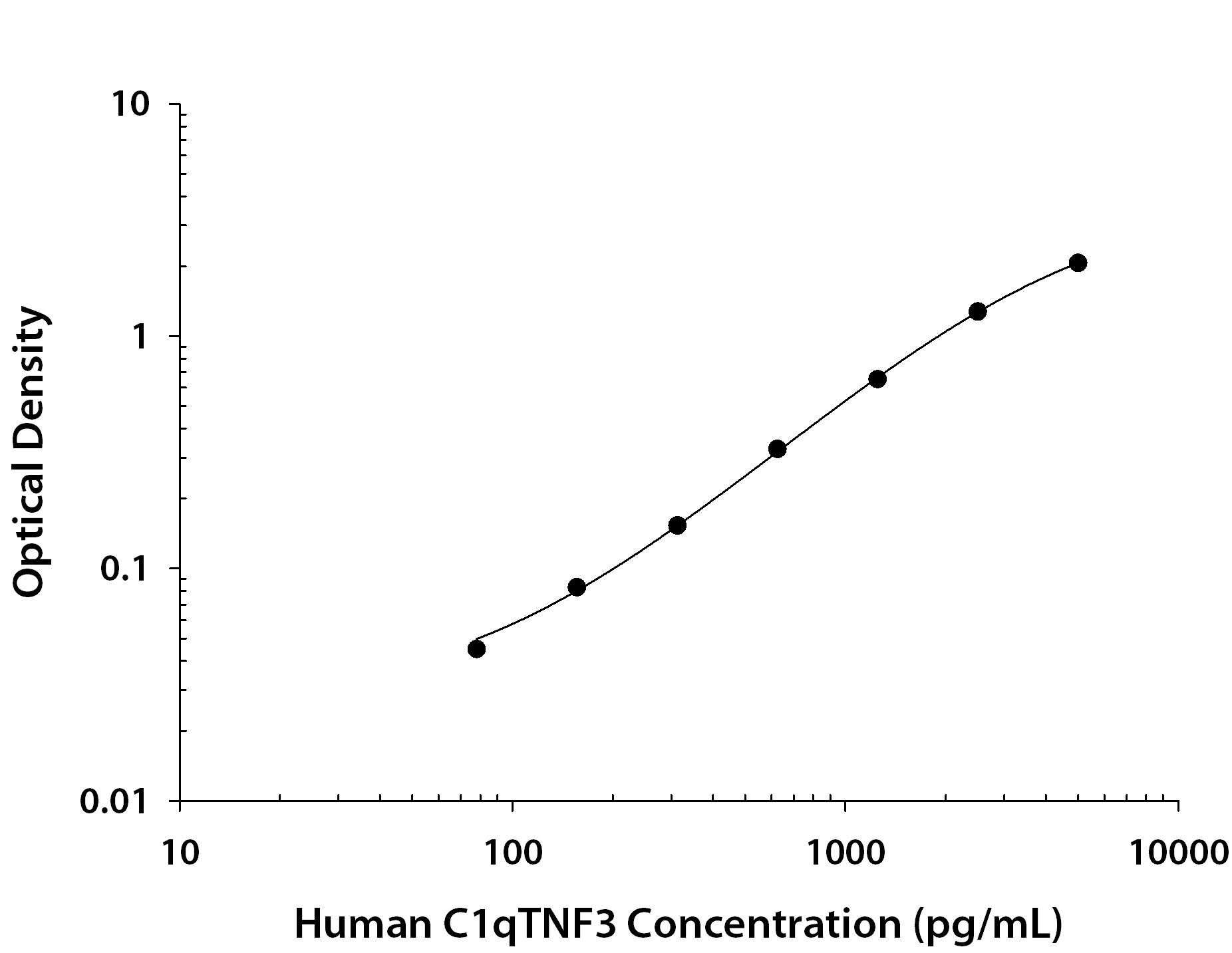Human CTRP3/C1qTNF3/CORS26 Antibody Summary
Gln23-Lys246
Accession # Q9BXJ4-1
Applications
This antibody functions as an ELISA capture antibody when paired with Mouse Anti-Human CTRP3/C1qTNF3/CORS26 Monoclonal Antibody(Catalog # MAB79251).
This product is intended for assay development on various assay platforms requiring antibody pairs. We recommend the Human CTRP3/C1qTNF3/CORS26 DuoSet ELISA Kit (Catalog # DY7925-05) for convenient development of a sandwich ELISA.
Please Note: Optimal dilutions should be determined by each laboratory for each application. General Protocols are available in the Technical Information section on our website.
Scientific Data
 View Larger
View Larger
Human CTRP3/C1qTNF3/CORS26 ELISA Standard Curve. Recombinant Human CTRP3/C1qTNF3/CORS26 protein was serially diluted 2-fold and captured by Mouse Anti-Human CTRP3/C1qTNF3/CORS26 Monoclonal Antibody (Catalog # MAB7925) coated on a Clear Polystyrene Microplate (Catalog # DY990). Mouse Anti-Human CTRP3/C1qTNF3/CORS26 Monoclonal Antibody(Catalog # MAB79251) was biotinylated and incubated with the protein captured on the plate. Detection of the standard curve was achieved by incubating Streptavidin-HRP (Catalog # DY998) followed by Substrate Solution (Catalog # DY999) and stopping the enzymatic reaction with Stop Solution (Catalog # DY994).
Reconstitution Calculator
Preparation and Storage
- 12 months from date of receipt, -20 to -70 °C as supplied.
- 1 month, 2 to 8 °C under sterile conditions after reconstitution.
- 6 months, -20 to -70 °C under sterile conditions after reconstitution.
Background: CTRP3/C1qTNF3/CORS26
CTRP3 (Complement C1q TNF-related Protein 3/C1qTNF3) also known as CORS-26 (Collagenous Repeat-containing Sequence of 26 kDa protein), Cartonectin and Cartducin, is a 30-32 kDa, secreted member of the C1q and TNF-related (CTRP) superfamily of molecules (1). The mature protein is 224 aa in length. It contains an N-terminal collagen-like domain followed by a C-terminal globular region. Human CTRP3 shares 99% aa sequence identity with the mouse CTRP3 (2). Like other CTRP members, CTRP3 has a trimeric structure and can assemble into hexameric or higher order molecular forms (3). It is expressed by a variety of cells, including adipocytes, cartilage, fibroblasts, monocytes and proliferating chondrocytes (4). The inflammatory effects of LPS, TLR-4 and fatty acids have been shown to be inhibited by CTRP3 in adipocytes and monocytes (5). In mouse models, CTRP3 has been shown to lower glucose levels and decrease gluconeogenic gene expression (6). Inhibition of 3T3-L1 pre-adipocyte differentiation to adipocytes is associated with CTRP3 treatment, demonstrating potential anti-obesity effects (7). Treatment with CTRP3 results in the proliferation of skeletal muscle C2C12 cells and inhibition of C2C12 myotube differentiation, mediated by the ERK pathway (8). Due to the variety of functions in metabolism and inflammation, CTRP3 is a potential new target of type 2 diabetes treatment.
- Wong, G.W. et al. (2004) Proc. Natl. Acad. Sci. U.S.A. 101:10302.
- Schaffler A. et al. (2003). Biochim Biophys Acta.1630:123.
- Suzuki S. et al. (2007) FEBS Lett. 581: 809.
- Weigert J. et al. (2005) FEBS Lett. 579: 5565.
- Kopp, A. et al. (2010) Endocrinology. 151:5267.
- Peterson J. M. et al. (2010) J Biol Chem. 285:39691.
- Nishimoto, H. et al. (2017) Cell Bio Int. 41:197.
- Otani M. et al. (2015) Mol Cell Biochem. 409:271.
Product Datasheets
FAQs
No product specific FAQs exist for this product, however you may
View all Antibody FAQsReviews for Human CTRP3/C1qTNF3/CORS26 Antibody
There are currently no reviews for this product. Be the first to review Human CTRP3/C1qTNF3/CORS26 Antibody and earn rewards!
Have you used Human CTRP3/C1qTNF3/CORS26 Antibody?
Submit a review and receive an Amazon gift card.
$25/€18/£15/$25CAN/¥75 Yuan/¥2500 Yen for a review with an image
$10/€7/£6/$10 CAD/¥70 Yuan/¥1110 Yen for a review without an image

